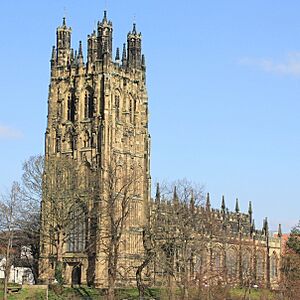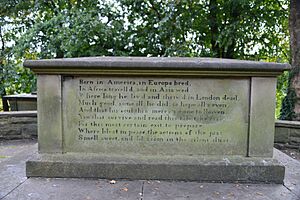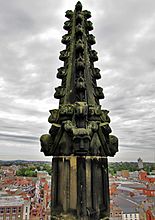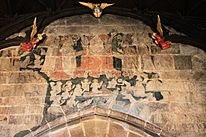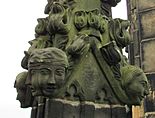St Giles' Church, Wrexham facts for kids
Quick facts for kids St Giles' Church |
|
|---|---|
| The Parish Church of St Giles | |
|
Eglwys San Silyn
|
|
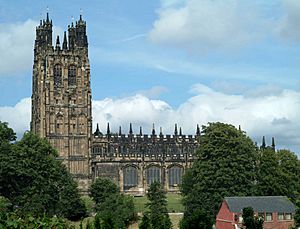
"The Glory of the Marches".
|
|
| Location | Church Street, Wrexham, Wrexham County Borough, LL13 8LS |
| Country | Wales |
| Denomination | Church in Wales |
| Website | St Giles' Church |
| History | |
| Status | Active |
| Architecture | |
| Functional status | Parish church |
| Heritage designation | Grade I listed |
| Style | Perpendicular |
| Years built | c. 16th century |
| Administration | |
| Parish | Wrexham |
| Diocese | Diocese of St Asaph |
St Giles' Parish Church, also known as Eglwys San Silyn in Welsh, is a very important church in Wrexham, Wales. Many people think it's one of the most beautiful churches in Wales. It's so special that it's a 'Grade I listed building', which means it's protected because of its history and beauty. Sir Simon Jenkins called it 'the glory of the Marches', and W. D. Caröe said it was a "glorious masterpiece."
The church has an amazing tower built in the 1500s. It stands 41 meters (136 feet) tall and can be seen from far away. This tower is so famous it's one of the 'Seven Wonders of Wales'.
People have worshipped on this spot for at least 800 years. The main part of the church you see today was built in the late 1400s and early 1500s. It's one of the greatest medieval buildings still standing in Wales.
Inside, St Giles' Church has many interesting things. You can find old carvings and statues from the 1300s. There are also monuments by famous artists like Roubiliac and Woolner. Look for a beautiful stained-glass window thought to be by Burne-Jones. The church also has one of the oldest brass eagle lecterns (a stand for reading) in Britain.
The grave of Elihu Yale is in the churchyard. He was a very important person who helped start Yale University in the United States. Because of this connection, one of the buildings at Yale University, 'Wrexham Tower', looks like the tower of St Giles' Church.
Contents
History of St Giles' Church
Early Beginnings
It's believed that a Celtic saint named Silin started a chapel here a long time ago. A record from 1620 mentions a piece of land called 'St Silin’s acre'. This shows how important Saint Silin was in the area. Both 'Silin' and 'Giles' can be translated to 'Aegidius' in Latin. By 1494, the church was known as 'Saint Giles'.
There might have been a church in Wrexham as early as the 1000s. The current church is probably the third one built on this same spot. The first mention of the church was in 1220. At that time, the Bishop of St Asaph gave half of the church's income to the monks of Valle Crucis Abbey in Llangollen. In 1247, Madog ap Gruffydd Maelor, a Welsh prince, also gave his support to the monks for the Wrexham church.
Rebuilding After Disasters
In 1330, a strong storm blew down the church tower. A new church was then built on the site. Some parts of that 1300s church are still part of the current building. Later, in either 1457 or 1463, a fire badly damaged the church. Work on the church we see today started on the same spot. It used some parts of the 1300s church, like its round pillars.
The main part of St Giles' was built between the late 1400s and early 1500s. It has many beautiful decorations with symbols of the Tudor royal family. It's thought that Lady Margaret Beaufort helped pay for it. She was the mother of King Henry VII. Her family had strong connections to the Wrexham area.
Church Through the Centuries
During the English Civil War in 1643, soldiers from the Parliament's army destroyed the church's original organ. People at the time called it 'the fairest organs in Europe'.
In the 1700s, the famous artist JMW Turner painted the church. The writer Samuel Johnson described it as a 'very large and magnificent church'.
A part of the church used to be Wrexham's first fire station. Since there were no fire engines, people would run to get ropes, water, and ladders. They would then run back to fight fires. In 2012, a webcam was set up to show a live view of St Giles'. In June 2012, a beacon was lit on top of the church for the Queen's Diamond Jubilee. In 2015, a rare first edition of the King James Bible from 1611 was found in the church. It had been stored there for centuries.
Architecture and Artworks
The Famous Tower
The church's tower is very decorated and has five levels. It is 135 feet high and has four cool hexagonal turrets. Building started on the tower in 1506. It is believed that William Hart of Bristol designed it. The tower has 30 niches and many statues and carvings. Some carvings show an arrow and a deer, which are symbols of Saint Giles. People think this tower might have inspired the Victoria Tower at the Palace of Westminster in London.
Inside the Church
The main part of the church, called the nave, has arches from the 1300s. The rest of the church is in a later style called Perpendicular. It has an unusual polygonal chancel (the area around the altar). This is similar to the one at Holywell, Flintshire, and like the Henry VII Chapel at Westminster Abbey.
Above the chancel arch, you can see large parts of a 'Doom painting' from the early 1500s. This type of painting showed the Last Judgment. The inside of the church has amazing carvings and statues from the 1300s and 1500s. The wooden roof from the 1500s has colorful wooden angels playing musical instruments. The church also has many monuments, including a detailed sculpture by Roubiliac. The brass eagle lectern was given to the church in 1524.
There are beautiful stained-glass windows. Some are by the studio of Burne-Jones in the north aisle. Others are by Charles Eamer Kempe and his company in the south aisle. The words of the hymn "From Greenland's Icy Mountains" are etched on one window. This hymn was written and first sung at the church in 1819.
The church has a medieval statue of a knight. It was found buried in the churchyard in the early 1800s. The knight has long hair and holds a shield with a lion. The words 'HIC JACET KENEVERIKE AP HOVEL' are on it, meaning 'Here lies Cyneurig ap Hywel'.
You enter the churchyard through beautiful wrought-iron gates. These were made in 1720 by the Davies Brothers from nearby Bersham. They also made gates for Chirk Castle, which are considered some of the best in Britain. They even made gates for Sandringham House.
Since 2012, the inside of the church has been changed. The Chancel area was made into St David's Chapel. The north aisle is now the chapel for the Royal Welch Fusiliers regiment, which is part of the Royal Welsh Regiment.
Grave of Elihu Yale
Just west of the tower is the grave of Elihu Yale. Yale University in the United States is named after him. Members of Yale University restored his tomb in 1968. This was to celebrate 250 years since he gave money to the university. His tomb has a poem he wrote himself, which starts:
Born in America,
in Europe bred,
In Africa travell'd and in Asia wed,
Where long he liv'd and thriv'd;
in London dead
There's a story that the gravestone was secretly taken by a group at Yale University called Skull and Bones. The story says it's displayed in a glass case in their hall. However, this story is not proven. The grave itself is a 'Grade II* listed structure', meaning it's a very important historical building.
Fun Facts and Legends
Local Legends
A local legend says that work on the church first started in a place called Brynyffynon. But every day, the work was destroyed during the night. As the work fell apart, a ghostly voice was heard crying "Bryn y Grôg". People believed this voice was a sign from above. It meant the church should be built on the nearby hill with that name instead.
Another legend says the church tower falling down in 1330 was a punishment. This was because the town's market was held on a Sunday. After the tower fell, market day was moved to a Thursday. The tower collapsed on St Catherine's day. A statue of St Catherine is now on the east wall of the tower, perhaps as a form of protection.
There's a carving, called a corbel, that might show Thomas Stanley, 1st Earl of Derby. For some unknown reason, it shows him with donkey ears.
In May 1581, a Catholic martyr named St Richard Gwyn was brought to St Giles'. He was carried around the font on the shoulders of six men. He was then laid in heavy chains in front of the pulpit. But he moved his legs so much that the noise of his chains made it impossible to hear the preacher.
There was a local story that Oliver Cromwell ordered a cannonball to be fired at the church tower during the English Civil War.
Cultural Connections
The church organ is mentioned in an old play from 1647 called The Pilgrim. In the play, a Welsh character says that "Pendragon was a shentleman... and the organs at Rixum were made by revelations".
One of the most popular hymns of the 1800s, 'From Greenland's Icy Mountains', was written by Reginald Heber. He wrote it during a visit to the vicarage. It was first sung in public at the church in 1819.
In Acton Park in Wrexham, there is a carved sandstone block. It was taken from the church during repairs in the early 1900s. People say it has magical powers. If you climb onto it, you won't be able to get off!
According to legend, there are many old underground tunnels under Wrexham city center. They are said to start somewhere under St Giles' Church and usually end in pubs nearby.
The church's tower is traditionally one of the Seven Wonders of Wales. These wonders are remembered in an old rhyme:
- Pistyll Rhaeadr and Wrexham steeple,
- Snowdon's mountain without its people,
- Overton yew trees, St Winefride wells,
- Llangollen bridge and Gresford bells.
The rhyme mistakenly calls the church's tower a "steeple".
Images for kids
-
J. M. W. Turner, 'Wrexham, Denbighshire' (watercolour, late 18th century)
-
'Wrexham Tower' of Yale University, US


